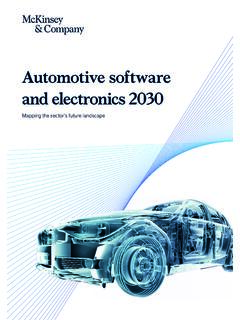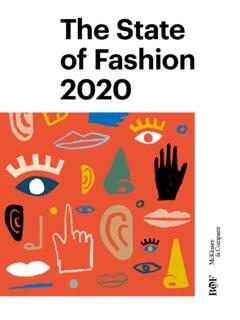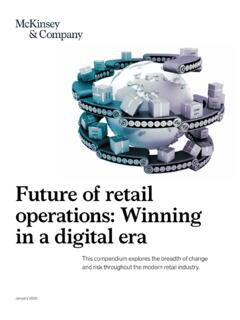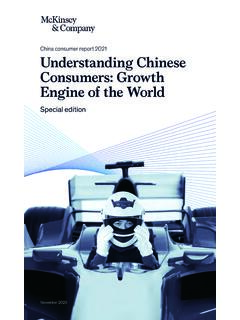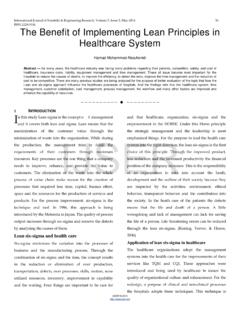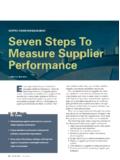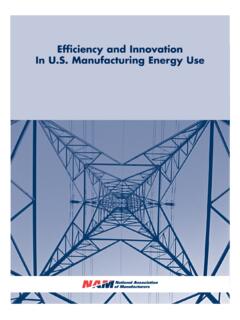Transcription of Industry 4.0: Capturing value at scale in discrete ...
1 Industry Capturing value at scale in discrete manufacturingContentsExecutive summary 6 Starting point Industry as the next s-curve in discrete manufacturing 8I. Where to focus factory archetypes and Industry -specific key value drivers Machinery key value drivers and target picture in a small-lot manufacturing Industry Automotive key value drivers and target picture in a mass-customized production Industry Consumer electronics key value drivers and target picture in a high-volume production Industry 36II. How to scale focusing on value , mobilizing the organization, and innovating the infrastructure Focus on key value drivers value backward, not technology forward Mobilize the organization it is all about people; tools alone will not solve the problem Innovate the infrastructure moving towards an integrated technology stack, optimizing locally before scaling globally 50 Outlook next steps for Capturing value at scale 53 Legal note 54 Disclaimer 54 Contacts 555 Executive summary With an estimated value creation potential for manufacturers and suppliers of USD trillion in 2025,1 high hopes are set on Industry to bring the next industrial revolution to discrete manufac-turing.
2 Yet, only about 30 percent of companies are Capturing value from Industry solutions at scale today. Approaches are dominated by envi-sioning technology development going forward rather than identifying areas of largest impact and tracking it back to Industry value drivers. Further governance and organizational anchor-ing are often unclear. Resulting hurdles related to a lack of clarity regarding business value , limited resources, and an overwhelming number of potential use cases leave the majority of com-panies stuck in pilot purgatory. To provide a perspective on how to get unstuck and finally capture real value through Industry in discrete manufacturing, our report illuminates two key questions: where to focus and how to on the latest McKinsey research and a series of interviews, we arrived at the following key insights:2I.
3 Where to focus factory archetypes and Industry -specific key value driversThree factory archetypes define the productivity imperative, which establish the relevant set of key value drivers Capturing impact at scale : Small-lot manufacturing aims to remain efficient down to lot size 1. Here, the key value drivers are an integrated product data model from engineering to commissioning, digital worker enablement, and data-driven OEE optimization. Mass-customized production focuses on enabling a certain degree of product variance while upholding high throughput and consistent quality. To this end, Industry value is in closed control loops (enabled by sensor-based, in-line quality inspection), flexible routing, scheduling, load balancing and performance management, and the extension of automation to final assembly.
4 High-volume production aims for fully automat-ed production and maximized OEE with flexibil-ity to adapt to the product mix. Industry key value drivers are closed control loops through sensor-based in-line quality inspection, con-quering the remaining domains of manual labor through automation and traceability. Industry target pictures, value drivers, and case examples for machinery (small-lot manufacturing), automotive (mass-customized production) and consumer electronics (high- volume production) provide hands-on examples of each archetype (please see Table 1 for an over-view on where to find specific case examples).II. How to scale focusing on value , mobilizing the organization, and innovating the infrastructureThree key principles guide Industry value capture at scale : Think value -backward, not technology- forward.
5 A focus on key value drivers and a compelling Industry vision are crucial. Be people centric, not tool centric. Backed by top-management support, Industry trans-formations need to focus on capability building and be pursued as a strategic organizational endeavor. As such, they should be informed by a clear business leadership mindset, not just by an engineering or IT process. Innovate the infrastructure towards an integrated technology stack and a clear target picture. Infrastructure should enable local operations before scaling globally, as many use cases deliver value already through on-premise The Next Economic Growth Engine Scaling Fourth Industrial Revolution Technologies in Production, WEF/McKinsey white paper, 20182 Three steps were taken in order to derive insights for this report.
6 Drawing on the latest McKinsey research from a global manufacturing survey with the discrete -manufacturing community, conducting a series of in-depth interviews with manufacturing practitioners across Industry verticals and Industry key value levers, and syndicating insights from structured interviews from our world-leading Industry operations ble 1 Overview of key value drivers and case examples for analyzed industriesIndustryKey value driver Case examplePageMachineryIntegrated product data model from engineering to commissioningANDRITZ Ritz implements seamless dataflow from CAD/CAM to machine tool controllers18 Digital enablement of workersIndustrial equipment manufacturer boosts efficiency through shop floor to top floor digital enablement20 Data-driven OEE optimizationDMG Mori technology helps Martin-Baker to achieve 80% OEE in high-variant machining22 AutomotiveFlexible routing, scheduling.
7 And load balancingPorsche deploys flexible AGV-based assembly line to optimize its electric vehicle production28 Closed control loops through sensor-based in-line quality inspectionFord automates quality control through camera-based in-line quality inspection30 Extension of automation to final and pre-assemblyBosch increases end-of-line parts inspection efficiency through flexible and collaborative robotization by Rexroth32 Consumer electronicsConquering remaining domains of manual labor through automationGlobal electronics contract manufacturer introduced robotic automation solutions to reduce its labor cost in selected areas by 80%40 Closed quality loops through sensor-based in-line quality inspectionSamsung uses cutting-edge 3D vision scan-ning to tackle growing demand and strict quality standards for LCD panels42 TraceabilitySeagate plans to utilize IBM Blockchain and electronic fingerprinting to track supply chain for hard drives447 Starting point Industry as the next s-curve in discrete manufacturing Industry , or the fourth industrial revolution, is expected to lead operations to the next s-curve of productivity.
8 McKinsey s recent research with the World Economic Forum puts the value creation potential of manufacturers and suppliers imple-menting Industry in their operations at USD trillion in its several key findings (see page 9), our global manufacturing survey reveals that 68 percent of companies see Industry as a top strategic priority today. How fast Industry has moved into the focus can also be seen by running a Google trends analysis. The search term Industry is likely to surpass lean manufacturing in 2019, despite being almost nonexistent prior to this high degree of attention on Industry , it is no surprise that 70 percent of companies have already started to pilot Industry solu-tions. What may be surprising, however, is that at the same time, only 29 percent of companies are Capturing value from such solutions at scale , with the rest being stuck in pilot purgatory.
9 But why exactly is the Capturing of value at scale through Industry lagging in so many companies? To answer this question, let us briefly refer to what the McKinsey global expert survey reveals about key roadblocks to the deployment of Industry solutions at scale and to what winners say about how to overcome them:4 USD trillionvalue creation potential in 20253 The Next Economic Growth Engine Scaling Fourth Industrial Revolution Technologies in Production, WEF/McKinsey white paper, 20184 The key roadblocks were identified based on the McKinsey global experts survey and reflect all roadblocks named as top three by at least 30 percent of many use cases to prove outIn many cases, companies have a plethora of use-case ideas identified yet struggle to quantify and prioritize the top value drivers to pursue.
10 Facing a long list of use cases, all being perceived as equally important, and limited resources to pilot the use cases on the list, many companies refrain from seriously deploying use cases at scale seeing the long list of potentially promising ideas not yet tested. This backdrop of opportunities and challenges illuminates two guiding questions, which are key to Capturing value at scale through Industry in discrete manufacturing: Where to focus? What are the most relevant Industry value drivers differentiated by fac-tory archetypes to capture value at scale ? How to scale ? What is required to enable the organization to generate value at scale from key value drivers, and what role does IT infra-structure play?To answer these questions, this report draws from the latest McKinsey research in the discrete man-ufacturing community and a series of in-depth interviews with manufacturing practitioners and globally-leading Industry operations Industry value capture at scaleIndustry becomes the new productivity imperative of discrete manufacturingWhile Industry is a strategic priority, value capture at scale is lagging behindTo unleash the power of Industry .


